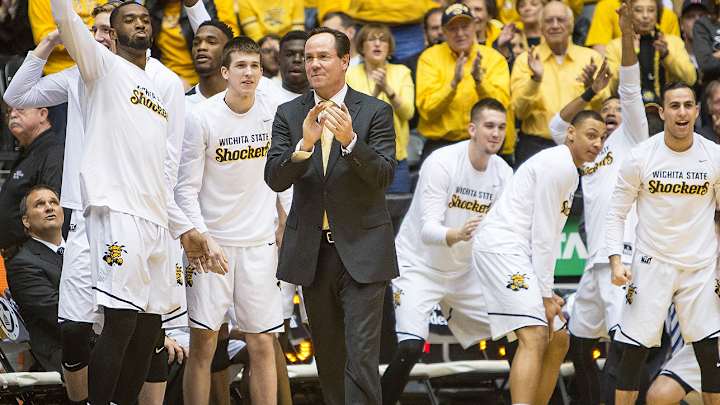Wichita State joining the AAC a realignment move that—for once—makes total sense

Every realignment move in college sports is born of at least a hint of dissatisfaction. A team thinks it deserves more. A conference wants more clout. New connections are made, and they’re often forced. Missouri in the SEC East despite lying farther west than all but two teams in the conference? Sure. The Big Ten stretching from Nebraska to New Jersey? Alright. We convince ourselves these moves make sense when they often, well, don’t.
On Friday, though, a piece of realignment news broke that trend. When the American Athletic Conference announced Wichita State would be joining its ranks effective July 1 as a basketball-only member, there was little head-scratching. It made sense for both sides. Here was a spread-out conference built from the fallout of a shifting league and a basketball powerhouse from a Kansas town that had outgrown its world joining forces and building their respective resumes. The Shockers are perennial national contenders. The AAC markets itself as having the strength to make a “Power Six” in college sports. On Friday, both those arguments got stronger.
AAC votes to add Wichita State starting with 2017–18 season
Let’s start with the basics: In 2017, the AAC saw two of its teams make the NCAA tournament, both as No. 6 seeds. SMU was an automatic qualifier after winning the conference tournament, and Cincinnati won an at-large bid. The Mustangs lost in the Round of 64 and Cincinnati in the Round of 32. Those results paled in comparison to the league’s tourney performance in 2016, when it sent four teams dancing: UConn, Temple, Cincinnati and Tulsa.
In football, the AAC has consistently established itself as the primary threat to the Power 5 hierarchy. In the past two seasons, it’s had three teams finish in the final AP top 25 poll. That level of prominence hasn’t extended yet to basketball, and its most storied hoops program, UConn, reportedly has flirted with rejoining the Big East in recent months. Adding Wichita State certainly raises the AAC’s basketball profile, and it should give the Huskies second thoughts before they consider their own conference switch.
As for Wichita State, this year’s tourney berth was its sixth in a row, dating back to 2011–12, when the Shockers finished the season ranked No. 18. They’ve won the Missouri Valley Conference tournament in two of those six years, including this spring, when the team went 27–4 in the regular season, losing just one conference game. (Two of its non-conference losses came to ranked programs, No. 10 Louisville and No. 24 Michigan State.) But even with that resume, Gregg Marshall’s team still received a No. 10 seed, ranked by the selection committee as the No. 38 team in the field. Meanwhile, Ken Pomeroy’s metrics pegged the Shockers the nation’s No. 8 squad, making theirs the biggest discrepancy of any team between tournament seeding and KenPom rating. That’s in large part due to Wichita State playing in the MVC, which had the 12th-ranked RPI of any conference this year. As a result, the Shockers have had to be pretty close to perfect in league play to earn a tournament berth. Even when it does tear through its Valley slate with little trouble, it often has had to settle for a disappointing seed. In fact, in 2016 Marshall’s squad lost just two conference games, going 23–7 in the regular season, yet earned only an 11 seed, forcing it into a play-in game. It won by 20 points.
Way-Too-Early Top 25 rankings for the 2017–18 college basketball season
It’s clear: the AAC could use a basketball upgrade, and Wichita State needs a conference to lend it a level of legitimacy, no matter how unfair that may be. Friday’s move solves both those problems, and though it doesn’t guarantee UConn’s allegiance to the AAC, it’s certainly among the strongest moves the conference could have made to urge the Huskies to stay. And yes, it may sound silly that a decision made in Kansas would sway a school in Connecticut, but in the case of the AAC, it’s not quite so ridiculous. The conference’s current form dates back only to 2012, when the so-called “Catholic 7” separated from the Big East and took its name. In 2013, the AAC was born from the group of schools that eventually absorbed Navy (for football only) and a handful of Conference USA teams. It was a modern alliance of necessity, with no claim of geographic unity. There’s no deep-seated history or set of rivalries to cling to, and so the addition of a Kansas team to a conference that already has members in 10 states doesn’t seem quite like the heresy of, say, Maryland in the Big Ten.
Of course the move brings questions. Could this be just the first domino of several, as alignment often is? There’s certainly cause to wonder if the AAC is finished, because if it can get the Shockers, why not swing even bigger and look west to Gonzaga and Boise State? There are also schools like VCU and Dayton, which fall within the conference’s already-established territory, to consider. Even one of those schools would further bolster commissioner Mike Aresco’s aims at making a Power 6 part of the college sports conversation.
As for Wichita State, the question of Marshall’s tenure becomes even more interesting. For years, the coach has been one of the first names brought up whenever a big job opens, yet he’s remained in the Valley, waiting, one would have to assume, for a moment like this one. He has a great gig as the big fish in a little pond, and now his team’s road to the tournament just got a whole lot easier. The move should make Wichita State even more confident in its ability to retain the coach long-term, and even if Marshall does eventually move on to a bigger program, that won’t negate the value of the Shockers to the AAC. At this point, they’re an established program and a desirable job.
Patrick Ewing hire is latest evidence of Big John's mammoth influence at Georgetown
Going into 2017–18, Wichita State will likely be the favorite to win the AAC as it brings back all of its contributors from this year’s team. (There’s a certain irony to that assumption given Wichita State’s No. 10 seed in March, compared with SMU and Cincinnati both being seeded sixth. Both the Mustangs and Bearcats will bring back plenty of talent, as well.) Marshall and his team will be the crown jewel of AAC basketball, and their presence should give a boost to the conference’s RPI, which was seventh last season. This is, for once, conference realignment that makes sense—and should also yield some really fun basketball.
Last season, Wichita State had an average point differential of +18.6, better than every team save Gonzaga. That number will more than likely decrease once the Shockers’ conference opponents are upgraded next season, making their games significantly more watchable—and likely to be televised thanks to the AAC’s rights deal. We’re going to get more good basketball in our living rooms, and though this will make Wichita State less of an exciting novelty come March, it’s an unequivocal net positive for college hoops fans across the country.
It’s hard to think of the last time anyone said such a thing about realignment.
